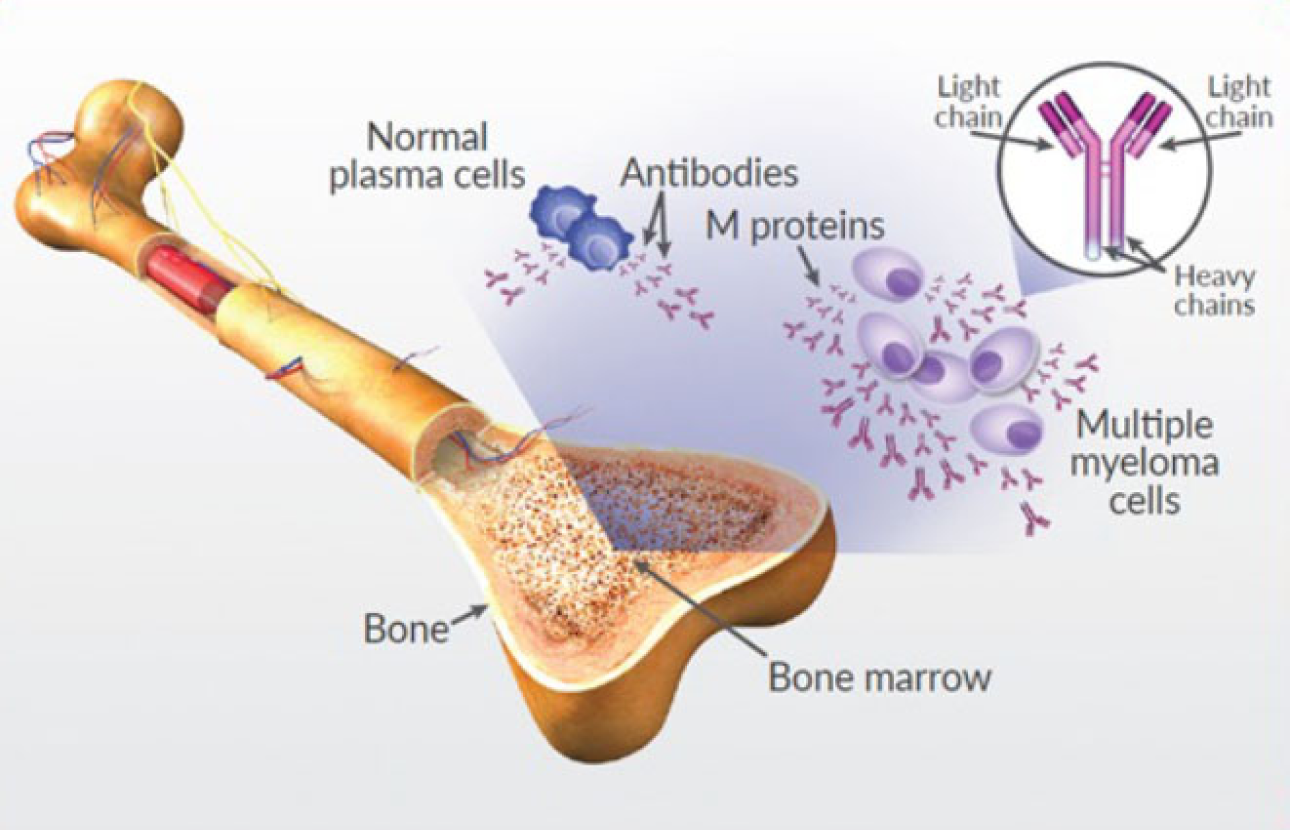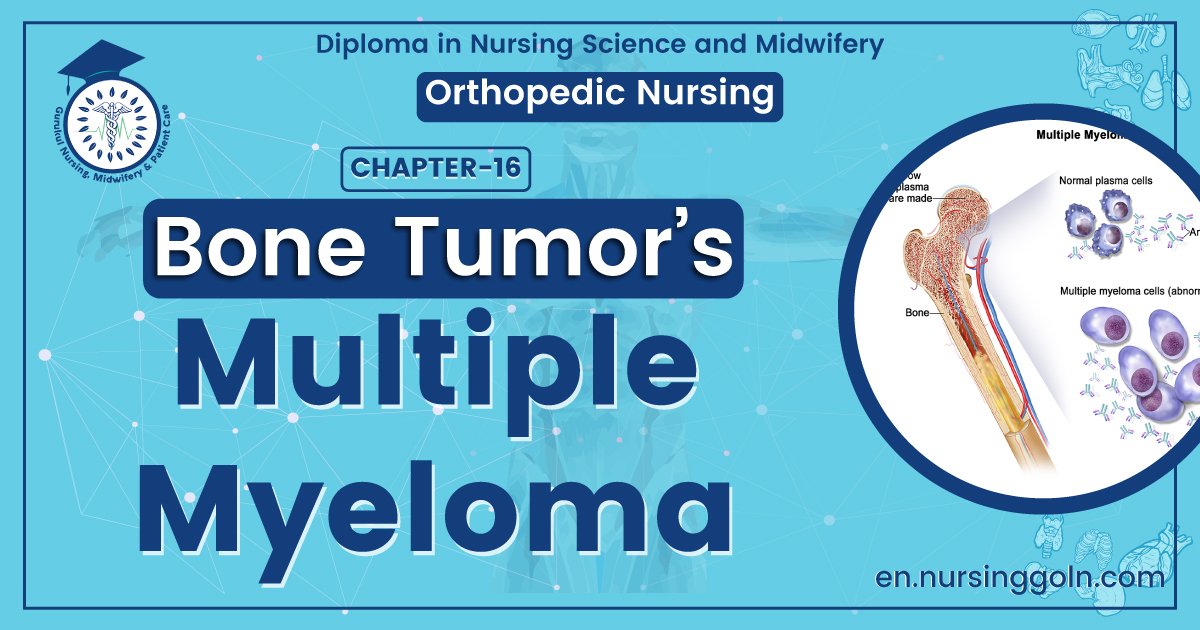Multiple myeloma – An orthopedic nurse is a nurse who specializes in treating patients with bone, limb, or musculoskeletal disorders. Nonetheless, because orthopedics and trauma typically follow one another, head injuries and infected wounds are frequently treated by orthopedic nurses.
Ensuring that patients receive the proper pre-and post-operative care following surgery is the responsibility of an orthopedic nurse. They play a critical role in the effort to return patients to baseline before admission. Early detection of complications following surgery, including sepsis, compartment syndrome, and site infections, falls under the purview of orthopedic nurses.
Multiple myeloma
Definition of Multiple Myeloma:
Multiple myeloma is a complex and diverse haematological malignancy that is poorly understood. It is cancer of the red bone marrow that produces excess amounts of cloned plasma cells. This is a malignant neoplastic condition characterized by multiple foci of plasma cells in the red bone marrow.
[Ref-JN ASTON’s, “Orthopedics and Traumatology”, 2 edition, P-272]
Or
Multiple myeloma is malignant B-cell lymphoproliferative disorder of the marrow, with plasma cells predominating.
[Ref- Apley’s “System of orthopedics and fractures”, 9 edition, P- 217]

Risk factors for multiple myeloma:
A risk factor is anything that changes a person’s chance of getting a disease such as cancer. Different cancers have different risk factors. For example, exposing skin to strong sunlight is a risk factor for skin cancer. Smoking is a risk factor for cancer of the lung and many other cancers. But risk factors don’t tell us everything. Scientists have found few risk factors that may affect someone’s chance of getting multiple myeloma.
1) Age: The risk of multiple myeloma goes up with age. Less than 1% of cases are diagnosed in people younger than 35. Most people diagnosed with this cancer are at least 65 years old.
2) Gender:Men are slightly more likely to develop multiple myeloma than women.
3) Race:Multiple myeloma is more than twice as common among black Americans as white Americans. The reason is not known.
4) Radiation:People who were exposed to radiation from an atomic bomb blast had a higher risk of multiple’ myeloma. Exposure to lower levels of radiation may also increase the risk of multiple ‘myeloma. At most, this accounts for a very small number of cases.
5) Family history: Multiple ‘myeloma seems to run in some families. Someone who has a sibling or parent with myeloma is 4 times more likely to get it than would be expected. Still, most patients have no affected relatives, so this accounts for only a small number of cases.
6) Workplace exposures: Studies looking at workplace exposures and multiple ‘myeloma risk have found no clearlinks.
7) Obesity: A study by the American Cancer Society has found that being overweight or obese increases a person’s risk of developing myeloma. 8) Other plasma cell diseases: Many people with monoclonal gammopathy of undetermined significance.
[Ref-www.American cancer sociery.net]
Clinical ‘features of multiple myeloma;
1) Age: Commonly found in middle age adult between 45-65 years.
2) Weakness.
3) Backache.
4) Bone pain.
5) Pathological fracture.
6) Plasma cell abnormalities.
7) Increased blood viscosity.
8) Anaemia.
9) Thirst.
10) Polyuria.
11) Abdominal pain.
12) Localized tenderness.
13) Restricted hip movements.
14) Cord or nerve root compression.
15) Chronic nephritis.
16) Recurrent infection.
[Ref- Apley’s “System of orthopedics and fractures”, edition, Page-214]

Complications of multiple myeloma:
1) Pathological fracture of the ribs.
2) Spinal cord or nerve root compression.
3) Anaemia.
4) Leucopenia.
5) Thrombocytopenia.
6) Renalfailure.
7) Severe infection.
8) Amyloidosis.
[Ref-John Ebnezar’s, “Textbook of Orthopedics”, 4 edition. P-636]

Diagnose multiple mveloma:
1) X-ray: often shows nothing more than generalized osteoporosis.
1) Blood test: Blood test will show-a great increase in the erythrocytic sedimentation rate (ESR).
2) Blood chemistry: may shows a raised creatinine level and hypercalcaermi.
3) Sternal puncture: To obtain a specimen of red bone marrow, will re-i great increase in plasma cells.

Management of multiple myeloma:
1) Chemotherapy.
2) Surgery:
a) Laminectomy: when there is compression of spinal nerves.
b) Intramedullary fixation: In case of pathological fixation.
3) Bisphosphonates.
4) Radiation.
5) Biologic therapy.
6) Stem cell transplant.
7) Plasmapheresis.
[Ref-John Ebnezar’s, “Textbook of Orthopedics”, edion, Page-637]
Read more:
